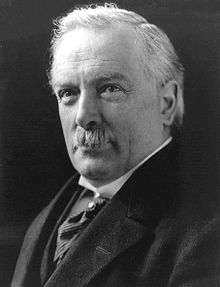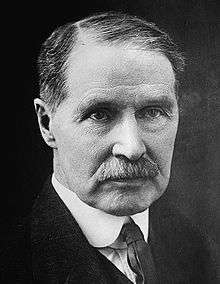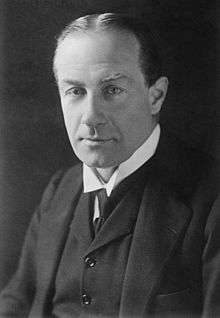Interwar unemployment and poverty in the United Kingdom

Interwar unemployment and poverty in the United Kingdom describes a period of poverty in the United Kingdom between the end of World War I in 1918 and the start of World War II in 1939. Unemployment was the dominant issue of British society during the interwar years[1] Unemployment levels rarely dipped below 1 million and reached a peak of more than 3 million in 1933, a figure which represented more than 20% of the working population. The unemployment rate was even higher in areas including South Wales and Liverpool.[1] The Government deployed unemployment insurance schemes in 1920 to alleviate unemployment.[2]
Causes
There were several reasons for the decline in industry after the First World War. The end of World War I brought a postwar boom. In the Shipping industry businesses expanded rapidly in order to take advantage in the increase in business. However the boom was short lived and this rapid expansion caused a slump from oversupply.[3] Structural weaknesses in the British economy meant a disproportionate number of jobs were in the traditional industries. A lack of pre-war technological developments and post war competition damaged the economy and the new industries which emerged employed fewer people. At the same time Britain began to lose her overseas markets due to strong foreign competition.[4] Some have argued than an overly generous unemployment insurance system worsened the state of the economy.[5] The Wall Street Crash in 1929 was responsible for a worldwide downturn in trade and led to the Great Depression.
Response
Liberal Party
As the Government had funded World War I largely through borrowing, Britain had run up a large national debt. A boom in the economy occurred in 1919 causing unemployment rates to decrease. The boom stopped in 1920 when unemployment began to increase, by the time that the Liberals lost power in 1922 the unemployment rate had reached 2.5 million. A committee on unemployment was set up in 1920 and recommended public works schemes to ease unemployment, this led to the establishment of the Unemployment Grants Committee. As unemployment was not uniform across Britain it was decided to concentrate schemes in areas of the country that were particularly affected by the downturn.[6] However the government wished, also, to return to the gold standard, a move which would have required cuts in public spending.[6] The Unemployment Insurance Act 1920 extended unemployment benefits to cover all workers who earned less than £250. The "Seeking Work Test" was introduced in 1921, it stated to receive full unemployment benefit there had to be evidence the recipient was looking for work.
Conservative policy
The Unemployment Insurance Act 1927 returned to the principle that workers had to contribute to insurance schemes in order to be a part of them. The workhouse system was abolished and replaced with a system of Public Assistance Committees.
Labour Policy
Ramsay Macdonald's Government passed the Development (Loan Guarantees and Grants) Act of 1929.
National Government
In 1931 a National Government formed after Cabinet splits resulting from the financial crisis. National Governments would stay in power from 1931-1940 until Winston Churchill became Prime Minister of a Coalition Government during World War II.
Local government was reorganized so that local authorities provided school dinners and health services, means testing was introduced and the Unemployment Assistance Board was set up in 1934. Economic measures included the devaluation of the pound and taking Britain's currency off of the gold standard, borrowing also increased. The Special Areas Act of 1934 attempted to inject finance into depressed areas and British industry was protected by protectionist measures such as state subsidies and import quotas.The 1934 Unemployment Act Part I increased the numbers covered by unemployment insurance and the Special Areas Act 1934 increased support for those areas of Britain which were considered to be worst hit by the depression.
Prime ministers
All three of the major political parties held power during this period. The first Labour Government came to power in 1924 and a National Government was formed in 1931.
| Portrait | Name | Entered office | Left office | Political party | Other ministerial offices held while Prime Minister | Monarchs served | Birth Place | Refs | |
|---|---|---|---|---|---|---|---|---|---|
 |
David Lloyd George | 7 December 1916 | 19 October 1922 | National Liberal | First Lord of the Treasury | George V | Manchester | [7] | |
 |
Andrew Bonar Law | 23 October 1922 | 20 May 1923 | Conservative | First Lord of the Treasury & Leader of the House of Commons |
George V | Rexton, Kent County, New Brunswick, Canada | [8] | |
 |
Stanley Baldwin (1st ministry) |
23 May 1923 | 16 January 1924 | Conservative | First Lord of the Treasury, Leader of the House of Commons & Chancellor of the Exchequer (1923) |
George V | Bewdley, Worcestershire | [9] | |
 |
Ramsay MacDonald (1st ministry) |
22 January 1924 | 4 November 1924 | Labour | First Lord of the Treasury, Leader of the House of Commons & Secretary of State for Foreign Affairs |
George V | Lossiemouth, Moray | [10] | |
 |
Stanley Baldwin (2nd ministry) |
4 November 1924 | 5 June 1929 | Conservative | First Lord of the Treasury & Leader of the House of Commons |
George V | Bewdley, Worcestershire | [11] | |
 |
Ramsay MacDonald (2nd ministry) |
5 June 1929 | 24 August 1931 | Labour | First Lord of the Treasury & Leader of the House of Commons |
George V | Lossiemouth, Moray | [12] | |
 |
Ramsay MacDonald (3rd ministry) |
24 August 1931 | 7 June 1935 | National Labour (National Government) | First Lord of the Treasury & Leader of the House of Commons |
George V | Lossiemouth, Moray | [13] | |
 |
Stanley Baldwin (3rd ministry) |
7 June 1935 | 28 May 1937 | Conservative (National Government) | First Lord of the Treasury & Leader of the House of Commons |
George V, Edward VIII, George VI |
Bewdley, Worcestershire | [14] | |
| Neville Chamberlain | 28 May 1937 | 10 May 1940 | Conservative (National Government) | First Lord of the Treasury & Leader of the House of Commons |
George VI | Birmingham, West Midlands |
Legislation
- Unemployment Insurance Act 1920
- Unemployment Insurance Act 1921
- Unemployment Insurance Act 1924
- Unemployment Insurance Act 1927
- Unemployment Insurance Act 1930
- Coal Mines Act 1930
- Import Duties Act 1932
- Unemployment Act 1934
- Special Areas Act 1934
- British Shipping (Assistance Act) 1935
- Cotton Industry (Reorgainsation) Act 1936
- Special Areas (Amendment) Act of 1937
- Cotton Industry (Reorgainsation) Act 1939
Unrest
There were several examples of unrest during this period, most notably the General Strike of 1926 and the Jarrow March of October 1936. There were also protests against the introduction of means testing and hunger marches organized by the National Unemployed Workers Movement.
References
- 1 2 Laybourn, Keith (1999). Modern Britain Since 1906: a Reader. Tauris History Readers. I. B. Tauris. p. 105. ISBN 978-1-86064-237-1.
- ↑ "The Cabinet Papers | Alleviating inter-war unemployment". Nationalarchives.gov.uk. Retrieved 2012-10-06.
- ↑ "The Cabinet Papers | Interwar period". Nationalarchives.gov.uk. Retrieved 2012-10-06.
- ↑ "Introduction". Making the Modern World. 1938-12-12. Retrieved 2012-10-06.
- ↑ Daniel K. Benjamin & Levis A. Kochin, "Searching for an Explanation for Unemployment in Interwar Britain", Journal of Political Economy 87 (1979), pp. 441-478.
- 1 2 "The Cabinet Papers | Lloyd George's coalition". Nationalarchives.gov.uk. Retrieved 2012-10-06.
- ↑ Rose (1983), pp. 196–198
- ↑ Rose (1983), p. 265
- ↑ Rose (1983), p. 272
- ↑ Rose (1983), p. 326
- ↑ Rose (1983), p. 337
- ↑ Rose (1983), p. 361
- ↑ Rose (1983), pp. 373–374
- ↑ Rose (1983), p. 398
External links
- Unemployment in interwar Britain
- 'We Danced All Night': A Social History of Britain Between the Wars by Martin Pugh
